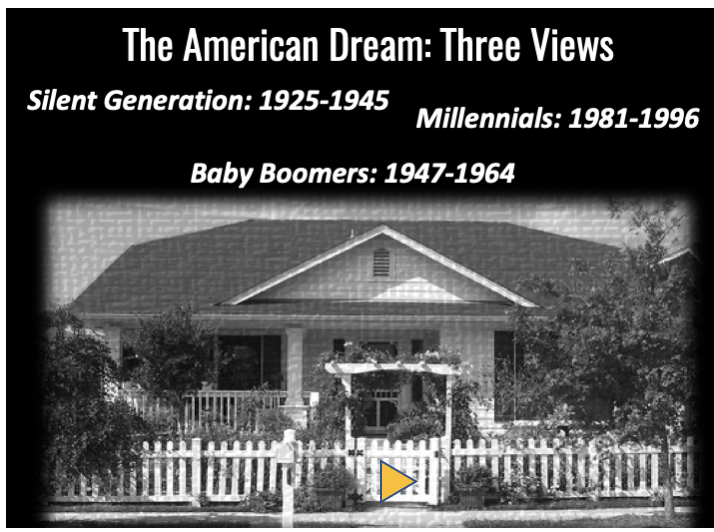What happened to the American Dream of Prosperity?
The sheer force of our middle class has been our driving economic engine and cultural foundation for 70 years. It’s how we define ourselves as Americans and what we aspire to, no matter how much we earn. The end of World War II was a watershed moment in our history. There was bottled-up demand for goods, and wartime factories began churning out cars, refrigerators, and other consumer goods for American homes. America’s unprecedented economic growth was supported by a rising middle-class fed by workers from rural and urban America, Mexico, Asia, and the Great Migration from the Southern US. But for too many Millennials, this has not been the case.
Context: The American Dream Interrupted
The foundation of the modern American economy was set in motion by the Silent Generation. These Americans, born between 1925 and 1945, came of age in the shadow of the Great Depression and World War II. They were hard-working and accustomed to just making ends meet. As the post-war economy burgeoned, their fortunes improved, and they were able to create a better life for their children—those we know as Baby Boomers, born between 1947 and 1964. They became the largest, most affluent, and best-educated generation in US history. We recommend Tom Brokaw’s treatises for two great historical perspectives—The Greatest Generation and Boom!.
Boomer children and grandchildren, the Millennials, were born between 1981 and 1996. As the first digital natives, they are well-educated and one of the most diverse generations in US history. But for them, the American Dream is fading fast: Too many of them have become America’s new working poor.
Here’s a glimpse into the lives of these three influential generations in their voices.

Millennial Experience: The Great Economic Stagnation
After decades of post-war prosperity, income has stagnated over the last 40 years, leaving 40% of Americans unable to make ends meet. As a generation, Millennials are being left behind because of low wages, lack of affordable housing, and crippling college debt.
Marketers and business strategists use complex segmentation models and algorithms to create effective ways of targeting key buyer groups–and, over the last five to ten years, targeting Millennials has become all the rage.
Marketers have rushed to understand Millennial’s digital behavior, brand affinities, and buying habits. But while we were trying to sell them more stuff, we failed to focus on understanding the impact of the economic challenges they are facing.
Repeatedly, our research has revealed that significant numbers of millennials feel the need to have side hustles due to underemployment. A speech therapist shared her story of taking on clients outside of regular working hours to pay back college loans. A teacher drives Uber by night to pay for medical insurance. The reality is that a whole generation has grown up in tentative economic situations that have made them distrust institutions and governments. Most Millennials came of age during the 2008 financial crisis and its aftermath and felt its impact on their ability to work and reach financial milestones. Despite these circumstances, too many Baby Boomers malign Millennials as selfish and entitled. Sean Illing offers another perspective worth considering in How the baby boomers — not millennials — screwed America.
Intergenerational squabbling is not productive. But we can agree that, as business leaders, brand marketers, policy-makers, and NGOs, we have failed this generation. Therefore, we must address the economic and social issues impeding millennials (and subsequent generations, such as Gen Z) as they work to reach milestones that depend on earning a sustainable living, from paying off college loans to buying a home and saving for retirement. Is this the foundation we want to set for future generations?
What changes are necessary to strengthen future generations’ economic fortunes? The $15.00 minimum wage is a good start, but as marketers, we must tackle this problem on several fronts and cannot afford to sit on the sidelines. How can we get started?
- First, go beyond the data to listen to the stories and challenges of Millennials in their voices. Use interactive methods to co-create solutions that drive economic and social well-being for your consumers, your employees, and society as a whole. Ethnographic consumer insights sessions with Millennial consumers and employees are excellent ways of ensuring their voices are heard. Learn about some new approaches we use–they are a font of great ideas!
- Second, understand policy solutions and incorporate this thinking into your Corporate Social Responsibility and Brand Purpose strategies. While there are many paths to building wealth in America, historically, several pillars of opportunity have played primary roles. These include access to education and training, the ability to secure a steady and well-paying job, support from family and community networks, and the ability to build savings and financial assets.
- Third, remember that all of your employees under age 41 are Millennials and Gen Z. Make sure you consider their unique concerns as you consider internal policies.
We are in this together and need your ideas, perspectives, and stories of progress. So please reach out to us at info@shedlight.org.
Suggested Reading and Viewing:
Bloomberg Wealth + Equality
Millennial Grandparents
Emerging Millennial Wealth Gap

